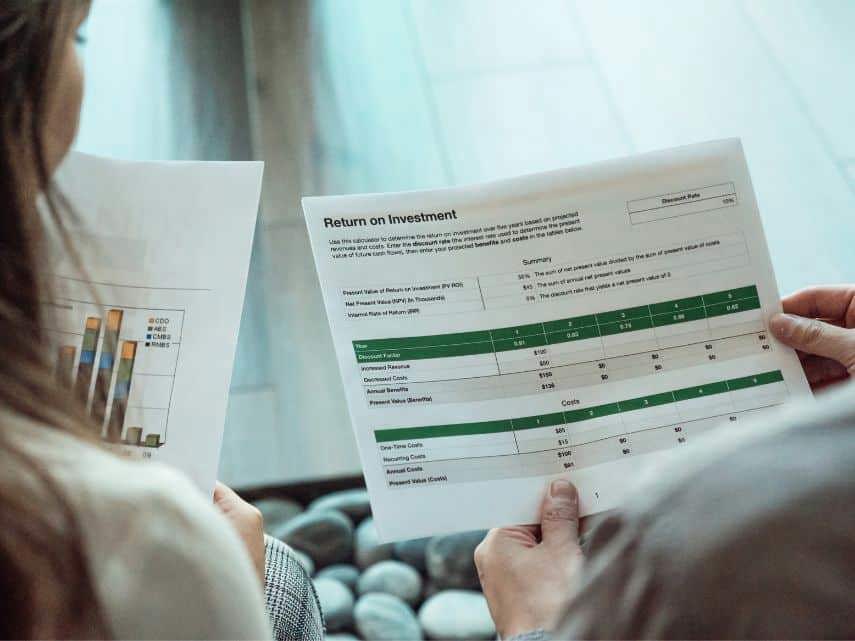
How you manage your inventory will directly impact the cashflow of your small business and when you fail to effectively manage stock you are putting your business at a disadvantage. Why? Because your cash is tied up in that very stock.
The correlation between inventory and cashflow is largely determined by the levels of inventory stock you hold, your inventory turnover, and your choice of inventory accounting method – as explained below.
Cashflow and inventory control: Brothers-in-arms
One of the best ways to improve cashflow and profitability is through inventory control.
Inventory generates cashflow but purchasing inventory requires a cash outlay that affects the company's cash balance.
An increase in inventory stock will appear as a negative amount in the cashflow statement, indicating a cash outlay, or that a business has purchased more goods than it has sold.
If, on the other hand, inventory stock has decreased, the reduction in inventory stock would be shown as a positive amount on the cashflow statement.
The cashflow your business generates is largely dependent on how you source and manage inventory. Holding more inventory than what is needed for current sales forecast and demand means using available cash to pay for the surplus inventory and converting current cash into non-cash assets.
 Proper inventory planning and risk mitigation will prepare your business for managing cashflow effectively.
Proper inventory planning and risk mitigation will prepare your business for managing cashflow effectively.
Inventory turnover and cashflow
Inventory turnover is a key measure of how well a business is doing, the inventory turnover ratio determines the number of times inventory stock is brought and sold within the company’s financial year.
Inventory turnover improves business cashflow when items are ‘turning over’ and not sitting unsold on the shelves. High turnover implies strong sales and requires increasingly efficient inventory control to meet this high demand and respond to market needs.
There are two ways of calculating your inventory turnover ratio:
The first is using the cost of goods sold (COGS), generally seen as a more accurate measure of profitability because it includes any carrying cost of goods sold, in addition to the purchase price.
- The COGS are subtracted from sales revenue to ascertain the businesses gross margins: (beginning inventory + inventory purchases) - end inventory
- The second method simply adds the beginning inventory for the period to the end inventory for the period and divides by two: (beginning inventory + end inventory)/2
The higher your inventory turnover ratio, the greater your cashflow. If the ratio is low, however, you are buying more inventory faster than you’re selling it and don’t have good inventory control.
Improving inventory turnover through proper stock control will help reduce the COGS, positively impacting cashflow and resulting in more cash in the bank.
 Getting the right inventory and cashflow tools in place can help you reduce financial challenges.
Getting the right inventory and cashflow tools in place can help you reduce financial challenges.
How poor inventory control affects cashflow
Cost 1: Reduced sales
One of the biggest mistakes a company can make when it comes to inventory control is failing to stock an adequate amount of inventory to align with demand.
In this situation, customers may begin to look to competitors if the company cannot provide the items they are looking for, leading to a loss in sales.
Problematically, this can have knock-on effects as well: the customer may provide a negative online review, or the message that your company is ill-prepared may simply spread via word-of-mouth.
This will obviously have major consequences for your company’s reputation, and it can reduce your customer base considerably.
One way of stocking the right amount of inventory is to forecast your demand.
Cost 2: Dissatisfied customers
Another major consequence of poor inventory control is customer dissatisfaction.
Imagine again the scenario in which a company has exhausted its supply of a fast-moving item in high demand – a customer may attempt to order this product, only to find out it is out of stock.
In the worst-case scenario, the customer may have even gone through with the entire purchasing process, only to be told they will need a refund in replacement of the missing stock.
This type of inventory control can have disastrous consequences for customer satisfaction; the customer will be left feeling frustrated and will likely move on to purchase from a competitor company. This will of course negatively affect your sales, as word gets out that the company has failed to deliver.
Cost 3: Obsolete stock
While poor inventory control may lead to inadequate stock levels as discussed above, it can also lead to an excess amount of stock.
This occurs when a company fails to order inventory in line with future demand so that demand is lower than expected and the company is left with stock that is unlikely to sell.
This can be a costly mistake to make when managing your inventory – excess stock means that your money is tied up in assets gathering dust on the warehouse shelves, and this, of course, can lead to a massive reduction in profit.
 Cashflow can be improved by focussing on inventory management and workplace optimisation.
Cashflow can be improved by focussing on inventory management and workplace optimisation.
10 ways to improve cashflow with better inventory management
Below we provide 10 useful tips to help you optimise cashflow using inventory management.
1. Invest in an inventory management system
Inventory management systems like Unleashed (see a demo) offer solutions that cater for your business needs. If you are unaware of what inventory stock you have on hand, it will be difficult to have an accurate insight into what to order and what is not selling.
2. Revisit your levels of safety stock
If you maintain safety stock, it is important to actually analyse whether or not you use it, how often you use it, and the benefits and costs of the levels you keep. You may be able to reduce the amount you keep in safety stock, and this can be aided by better inventory management solutions.
3. Stop making or buying items that don’t sell
It can often be hard to let go of some items, but if this inventory stock really isn’t moving, it is a waste of cash, costing your business money and making you less profitable. Consider how you can get rid of excess stock.
4. Implement internal controls
It is important to have internal controls on how inventory stock is handled to help avoid inventory shrinkage, such as damage due to employee carelessness or a least pleasant problem of losing inventory items to employee theft. Also note, that employee theft of inventory items also happens at receiving shipments.
5. Break down and report your inventory into three categories
Categorising your inventory into these three categories of safety stock, replenish stock, obsolete stock will help you stay organised. Analysing inventory stock this way helps you make smarter purchasing decisions.
6. Develop a company policy to deal with dead stock
It is critical to identify and liquidate dead stock such as obsolete stock that you can no longer sell in your typical business settings.
Decide on strategies that will help you move dead stock and then execute the action inventory items every month or every quarter – whichever makes sense to your business.
 Cashflow can be improved by eliminating dead stock, also known as unsaleable inventory, from your warehouse.
Cashflow can be improved by eliminating dead stock, also known as unsaleable inventory, from your warehouse.
7. Reconsider bulk purchase discounts
You may be getting your inventory stock at a discount, but you may be purchasing too much of any one item.
If you are struggling with cashflow, bulk purchasing is not the best fix. Take advantage of bulk discounts once you get your cashflow under control.
8. Pay attention to your supplier accounts
If you let your supplier order and stock inventory for you, ensure you have a system in place to closely monitor their actions.
9. Consider dropshipping
If dropshipping works for your business model, consider using dropshipping to optimise cashflow.
10. Try financing your inventory
If financing your inventory works for your business in order to free up cashflow, then consider the cost-benefit analysis of this. However, ensure you implement a system that immediately pays off the debt when inventory is sold.
For example, if you financed $10,000 worth of inventory and sold $3,000 of it in the first week, pay off that $3,000 in a timely manner so the principle is decreasing.
9 ways inventory management software can help with cashflow
Innovative technologies have made their mark on every aspect of manufacturing, retail and eCommerce business, from product design through to after sale service.
Understanding the significance of readily available raw materials, work-in-progress and finished goods should help decision-makers see that investing time and money into modern inventory solutions is critical to operational success and customer service delivery.
1. It champions modern assembly needs
Advanced inventory control plays an important role for manufacturers managing large volumes of highly configured, personalised products.
Operational tactics, such as hub and spoke design and distribution, allows manufacturers to utilise modular design concepts and mix and match components.
The different systems of a product can be assembled and stored, with final assembly only taking place once an order is received. The customised finishes, accessories and details are then added per the customer’s unique specifications.
This modular design tactic is becoming increasingly common as manufacturers seek to meet customer demand for specialised and customised products.
Modern inventory solutions help manufacturers manage this system of storing and staging partially assembled products, components and compatible add-ons.
2. Real time inventory control
Online inventory management provides real-time inventory control with up-to-the-minute inventory data, providing a complete picture of what’s happening in your organisation and enabling you to react quickly to supply chain needs.
Modern inventory solutions provide real-time information that records every transaction, from new stock purchases to outgoing sales and order shipments.
Updating your stock levels instantly lets you know what, where and how much inventory stock you have at any given time. Helping to improve the overall speed and efficiency of your service.
3. Improved tracking
Modern inventory solutions and online inventory management can also be used in the warehouse to improve inventory tracking that helps to reduce errors and speed up your pick and pack processes.
Barcodes scanners, RFID technology and sensors with GPS tracking can all be used to help warehouse staff quickly find and pick products from shelves.
For manufacturers with hundreds or even thousands of SKUs, multiple possible versions and kitting requirements, saving time on each order will quickly add up to a significant cost savings.
Online inventory management also improves accuracy which leads to increased customer satisfaction because orders can be tracked from the time they were placed, until the goods are delivered to the end-user.
Cashflow and inventory must be monitored together to improve liquidity and avoid risks of freezing sales.
4. Better cashflow
A significant benefit of modern inventory solutions is that it allows companies to have the right amount of stock in the right place at the right time.
Predictive analytics give managers the confidence to tighten inventory levels, reduce safety stocks and promote ‘just in time’ strategies to optimises space, time and cash flow, ensuring capital is not tied up unnecessarily.
The accuracy in financial reporting is greatly improved because accurate calculations of inventory product volume, enable the immediate and accurate listing of inventory value for end-of-month accounting, quarterly and annual financial reporting.
This is important because an incorrect ending inventory can impact many of your business and its profitability.
One of the best ways to improve cashflow and profitability is through inventory control.
5. Multichannel integration
Modern inventory solutions help you to manage sales, orders and inventory, integrating with other eCommerce platforms, simplifying administrative processes by syncing data between all platforms into one central place.
Make manual entry account is a thing of the past with online inventory management software that integrates with accounting software such as Xero. A modern system adds an accounting entry automatically whenever a transaction occurs, managing separate sales locations and multiple payments.
Additionally, automatic supplier orders mean you can automatically refill inventory stock through your online inventory management software.
When stock of a given product reaches a predetermined threshold, a new order will be automatically placed with your supplier. Barcode integration then allows you to track product movements in the warehouse more easily, reducing the risk of theft, human error and end of the year inventory discrepancies.
A robust, modern inventory management system can integrate with all areas of your business and will improve both your cashflow and customer relationships.
6. Better Planning
Accurate forecasting is a major challenge of business planning, what with the need to navigate the variations of demand consistency, seasonal highs and lows or anticipating the unexpected. Without effective inventory control, you could be undertaking trials with considerable error.
A major benefit of inventory management is the ability for better forecasting. The historic data it provides, along with accurate sales data, seasonal trends, product supply information, delivery and lead times will help guide procurement decisions.
 Putting the right plan in place for managing cashflow and inventory will help you stay afloat in times of financial uncertainty.
Putting the right plan in place for managing cashflow and inventory will help you stay afloat in times of financial uncertainty.
7. Accurate intel for the sales team
Maintaining the stock necessary for the realization of your business purpose is a subtle balancing-act. You need to determine how much stock is required to meet consumer demand while reducing carrying costs and minimising waste.
Inventory management helps track products into and through the organization. Improving the balance is only possible when you are aware of what products are in stock, overstocked or need replenishing.
Knowing your finished goods inventory allows you to quickly convey information to sales staff, so they know what is available and ready to ship at any given time. Up-to-date sales reports, demand data, supplier lead times and shipping schedules help you calculate buffer stock if an emergency arises or units of stock prove defective.
In fact, a robust sales and operations plan can help the business track profitability and guide decision making about the future to achieve sustainable growth without the need for major investment.
8. Greater productivity
Productivity and efficiency are greatly enhanced through good inventory management.
The use of RF scanners and software programs improves the ordering processes. It reduces labour costs because there is less handling. The improved productivity frees up staff to concentrate on more important activities.
Better warehouse operations will improve dispatch and delivery activities. Knowing where the stock is located and ease of accessibility improves picking, packing and shipping efficiencies and speeds up order fulfilment. Quick deliveries increase customer satisfaction.
9. Improved customer service
Our customers are essentially what keeps your business running. Inventory management enhances customer service, can drive competitive advantage and encourage repetitive purchasing habits.
Systems track sales records. The ability to identify high turnover items gives you the means to ensure the on-hand availability of popular items. Accurate data reflects product availability to meet shipping schedules, improve fill rates or provide same day delivery.
In a highly competitive global market customer satisfaction can be the key differentiator between you and the competition. Good customer service improves customer satisfaction and fosters loyalty to deliver customer lifetime value.
Taking control of inventory
Your inventory management system is a key factor of success that needs to be implemented across all locations and channels. Inventory management software provides real-time visibility of key inventory control measures through consistent stock tracking and analysis.
Place inventory control at the forefront of your business with a single system so that all areas, from purchasing and production to sales, have real-time access to the same information, increasing productivity and profitability.
More posts like this:
